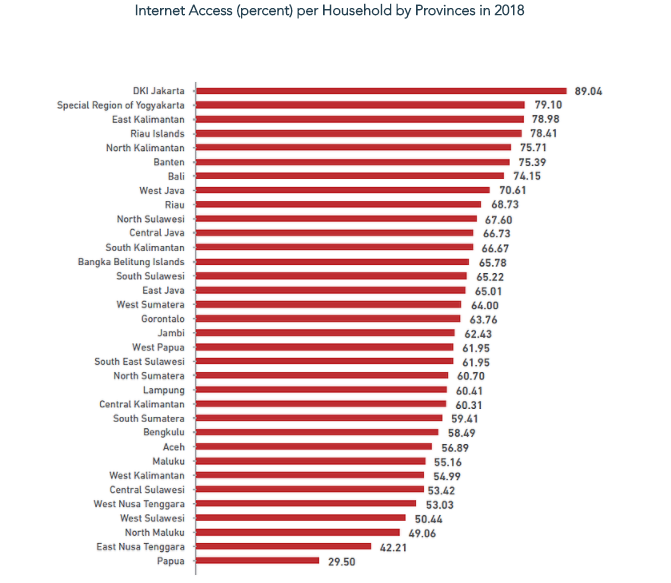The Connectivity Gap in Indonesian Distance Learning
The irony of using technology in education in Indonesia
In recent months, news has emerged about the difficulty of accessing the internet for distance learning, especially for students in rural or remote areas. Some are forced to gather at funerals to get better internet access, some use HT (handie talkies) because it is considered cheaper than having to buy internet quota. This condition increasingly shows the digital or technological gap that occurs in the world of education in Indonesia.
The COVID-19 pandemic has succeeded in forcing the world of education to transform rapidly, but at the same time it has brought some crucial issues to the fore. Common problems, which have existed for a long time, include differences in social status and unequal infrastructure development, thus having a real impact on the gap in access to quality education.
Since the government implemented the distance learning policy in March 2020, the gap between the poor and the rich, urban children and regional children has become increasingly visible. It's just that we focus too much on the same topic. One of them is the issue of technology.
Technology actually provides opportunities for wider educational equity solutions, but unavailability of infrastructure make the gap bigger.
Disruption of education during a pandemic
Before Covid-19 hit all corners of the country, disruption in the world of education had started a long time ago. Over the past decade, the digital wave that has hit the education industry has created disruptions, one of which is in the field of educational technology or edtech.
Services EdTech in Indonesia began to become hyping into the 2015s – although startups like Zenius have been around since 2004. Other big players, like Ruangguru and HarukaEdu, which just debuted in 2013. The popularity of these platforms also follows the growing digital trends in society, including distribution broadband which is expanding, the community is getting more familiar with application-based services, to more digital payment options.
Research team DSResearch recently published a report titled Edtech Report 2020 which discusses the ins and outs of the world of educational technology in Indonesia.

As 2020 kicked off, just before COVID-19, online education began to gain recognition for being considered sufficient, or even more effective, than traditional classroom education. Innovative digital learning technologies are entering the market, while more and more people are being connected online around the world thanks to public and private investments in network infrastructure. Digital literacy is developing in society, especially among young people.
Distance learning challenges
After the Minister of Education and Culture stated that the COVID-19 pandemic did not allow teaching and learning activities to take place normally, hundreds of thousands of schools were temporarily closed to prevent the spread. Around 68 million students are now learning from home, and approximately four million teachers are teaching remotely. This creates opportunities for the technology industry to play a role in continuing the education of students throughout the country.
The concept of distance learning (PJJ) is actually not new, but the diversity of Indonesia's regions is a big challenge to achieve equal access to education.
As stipulated in the Minister of Education and Culture Decree No. 4 of 2020 concerning the Implementation of Education Policies in the Emergency Period for the Spread of Covid-19, education units must conduct distance learning since the end of March 2020. It is undeniable, this method leaves many gaps, but currently online distance learning is the best scenario of what worst.
In its implementation, PJJ generates very varied responses from all elements of the school (teachers, students and parents). Some responded positively, some protested, some were still confused. The support of facilities, administration, and the economic background of students can be said to be a trigger for reactions to changes in the world of education. Schools that are included in the criteria for the upper middle class certainly do not find significant problems in implementing this PJJ concept.
In a paper published by CIPS, who discusses the challenges in Distance Learning, said the sudden shift from face-to-face methods in the classroom to distance learning at home shows the need to increase teacher capacity. The report also discusses unequal access to the Internet, disparities in teacher qualifications and quality of education, and lack of ICT skills as vulnerabilities in distance learning initiatives in Indonesia.
Tim DailySocial chatted with one of the education observers, Budi Muhamad, who is also known as bukik, regarding this issue.
He said, "In face-to-face learning, the teacher often acts as a control tower that monitors, reprimands and disciplines students' behavior. Distance learning makes teachers lose the ability to control students. There is no choice of role for teachers other than being a facilitator. only a few teachers are ready to act as facilitators, especially parents who have never attended education to become educators."
There is no age limit, almost all levels apply the distance learning system. For early, primary, and junior secondary education levels, jet lag or something culture shock prone to occur. Basically, at the age of 12 and under, education is not only about knowledge and skills, but also values and emotions. At this level of education, digital technology is not a concrete solution.
However, at other levels, such as high school and college, digital technology should be absorbed and adopted in several aspects. Several educational technology services have started to offer blended learning, learning that combines face-to-face and online.
What is still a problem is those who are at the vocational school or vocational school level, which incidentally is a school that relies on skills as the output of its students. Fully digital here may take time, especially for those who need labs for practice, and other field projects.
Bukik added, "Distance learning changes the rhythm of learning. The learning rhythm that has been controlled by the teacher has changed to being regulated by the teacher, students and parents. In the past, the three parties agreed on the learning time. For example at 8-12, the teacher, students and parents did efforts to hold learning at the agreed time. Meanwhile, in distance learning, there are a number of differentiating factors, starting from the ability of parents, parents' busyness, number of children, availability of gadgets and internet access."

The pandemic has forced the education sector to transform rapidly and adopt digital technology massively and thoroughly. The government, through the Minister of Education and Culture, has offered solutions, revised several times to suit conditions.
Various attempts to stay empowered
The world of education in Indonesia is like being struck by lightning in broad daylight. The pandemic came at a time when the Minister of Education and Culture was starting to aggressively implement its work program. A number of plans had to be pushed back and replaced with other plans to immediately anticipate the impact of the increasingly widespread pandemic. If it is mapped more broadly, the problems may be many but many parties have started to take their respective roles.
Not only the government, quick action in order to help the world of education came from a number of parties. Like operators who flock to present special quota packages for studying at home at affordable prices. Not only that, the government has also launched a quota subsidy for all elements of education, from teachers, students, students to lecturers.
On the other hand, this condition is a perfect laboratory for educational technology services. Demand of digital services is at an all-time high. Those who in fact enter as an educational technology service are also busy trying to come up with solutions. Ranging from easy access to content to complete technology that enables classroom management.

The Ministry of Education and Culture also partners with the edtech industry. One of them is Quipper to provide learning video shows through the TV Education channel which is broadcast on TVRI for free. This effort is one way to continue to provide educational content for students who cannot access the internet and only have TV frequency access (TVRI). Unfortunately that wasn't enough.
Too often dealing with gadgets makes children of primary and secondary school age tend to get bored more quickly. This is a heavy task and burden for teachers. At this point the help of parents or guardians is needed.

Cooperation between teachers and parents is a must. Both must have a commitment to making children learn in a fun way but still able to increase knowledge. The existing curriculum is impossible to catch up with the current conditions. For this reason, the government issued emergency curriculum, with the hope that children will continue to learn and grow in the midst of the chaotic conditions of this pandemic.
Meanwhile, for higher levels, like it or not, there must be a better solution. Especially for vocational schools for practical lessons.
For the high school level, students can be helped by the existence of educational technology services with a series of learning content that is packaged attractively and full of gamification. However, practical experience is hard to replace. The hands-on experience of being involved in a project, handling heavy equipment, and the like cannot be replaced by simulations or simply online learning. Something that is still a problem.
- Prayogo Ryza contributed to writing this article
Sign up for our
newsletter
